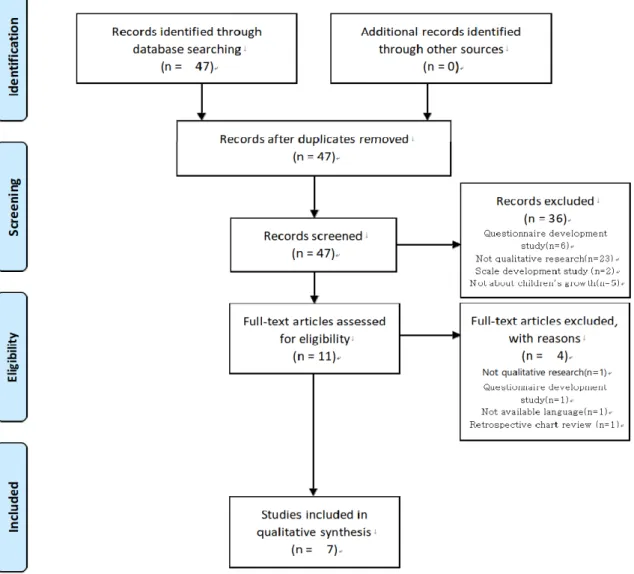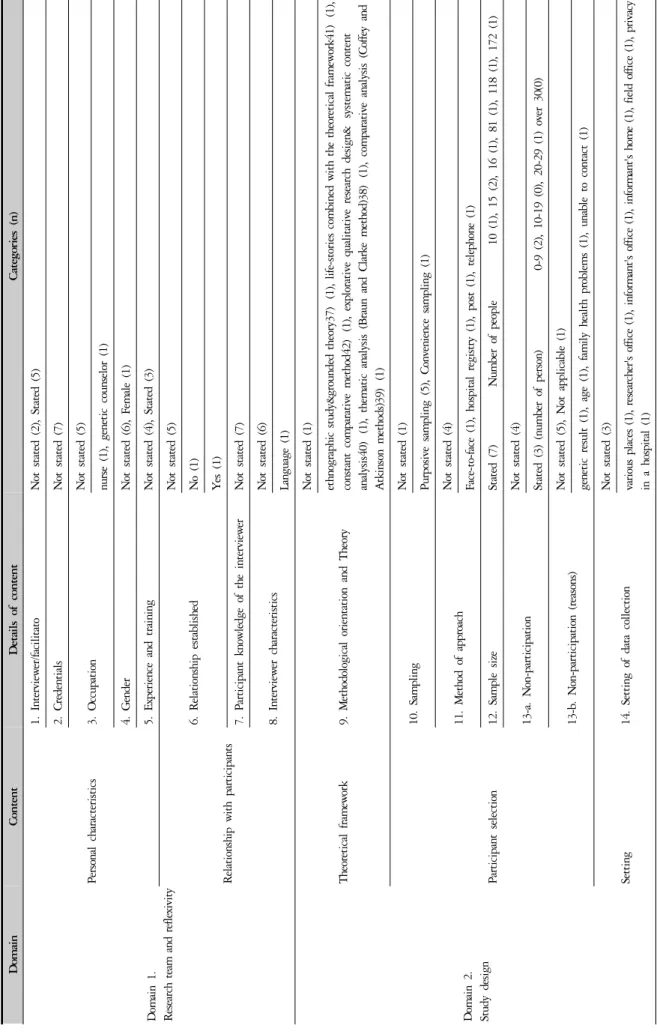저신장 및 성장과 관련된 질적연구에 대한 체계적 문헌 고찰
김혜진1․전채헌2․노민영3․한예지1․김현호4,6․정문주5*․임정태3,6*
1동신한방병원 한방소아과, 2동신한방병원 한방재활의학과, 3동신한방병원 한방내과,
4동신한방병원 침구과, 5원광대학교 사범대학 교육학과, 6청연중앙연구소
Received: October 25, 2019 ∙ Revised: November 20, 2019 ∙ Accepted: November 21, 2019 Corresponding Author: Leem Jungtae
351, Omok-ro, Yangchun-gu, Seoul, Korea
Tel: +82-2-2640-2902 / Fax: +82-2-2640-2727 / E-mail: julcho@naver.com Corresponding Author: Cheong Moonjoo
460, Iksandaero, Iksan-si, Jeollabuk-do, Korea
Tel: +82-63-850-6860 / Fax: +82-63-850-6666 / E-mail: sasayayoou@naver.com
ⓒ The Association of Pediatrics of Korean Medicine. All rights reserved. This is an open-access article distributed under the tenus of the Creative Commons Attribution Non-Commercial License (http://creativecommons.org/licenses/by-nc/3.0/), which permits unrestricted non-commercial use, distribution, and reproduction in any medium, provided the original work is properly cited.
Abstract
Systematic Review of Short Stature and Growth Related Qualitative Researches
Kim Hye Jin1․Jeon Chae Heun2․Roh Min Yeong3․Han Ye Ji1․ Kim Hyun Ho4,6․Cheong Moon Joo5*․Leem Jung Tae3,6*
1Department of Korean Pediatrics, Dongshin Korean Medicine Hospital
2Department of Korean Medicine Rehabilitation, Dongshin Korean Medicine Hospital
3Department of Internal Medicine of Korean Medicine, Dongshin Korean Medicine Hospital
4Department of Acupuncture & Moxibustion Medicine, Dongshin Korean Medicine Hospital
5College of Education, Wonkwang University, 6Chung-Yeon Central Institute
*Co-correspondence (공동교신저자)
Objectives
The aim of this study is systematic evaluation of the quality of qualitative studies related to short stature. It will be utilized as fundamental data for future qualitative research about Korean Medicine Pediatrics treatment for short stature.
Methods
We searched qualitative studies related to short stature in the Pubmed. Two researchers independently assessed the quality of the qualitative researches by using Consolidated criteria for reporting qualitative research (COREQ) and Critical Appraisal Skills Program (CASP). We also qualitatively synthesized theme of each included studies. We presented integrated theme and categories with in vivo coding about qualitative research about short stature.
Results
A total of 47 papers were screened and 7 papers were finally selected. In the quality assessment using COREQ, detalied information about the researchers, methods of approach, reasons for non-participation, presence of non-participants, participant’s review of the transcript, and participant’s review of the findings were insufficient. In the quality evaluation using CASP, there were lack of justifications for the research methods, description method of research, and bias in process of data analysis. The findings were synthesized into three themes: fixed idea about height, discomfort caused by small stature and personal coping strategy with stress caused by short stature.
Conclusions
In further qualitative research, it is necessary to report the research according to COREQ and CASP checklist.
It is also necessary to understand the stress and coping strategies to short stature of patients, We need to develop a social management strategy for short stature.
Key words: Qualitative research, Systematic review, Short stature, Korean pediatrics
대한한방소아과학회지 제33권 제4호(2019년 11월) J Pediatr Korean Med. November, 2019;33(4):74-88 ISSN 1226-8038(Print), 2287-9463(Online), https://doi.org/10.7778/jpkm.2019.33.4.74
Ⅰ. Introduction
소아는 태아, 신생아, 영아, 유아, 청소년을 거쳐 성 인이 되기 전까지의 아이를 뜻한다1). 소아는 성인과는 달리 성장을 한다. 성장이란 신체의 양적 증가를 말하 며 주로 키, 몸무게의 증가를 뜻한다2). 또한 성장은 유 전적 혹은 환경적 요인에 의해 영향을 받을 수 있는데2) 그 원인에 따라 왜소증, 저신장, 원시 왜소증, 1차성 성 장장애, 2차성 성장장애 등으로 구분된다3).
최근 외모를 중시하는 사회적 분위기가 점점 더 고 조되어4) 키 또한 외모의 한 요소로 작용하고 있다. 따 라서 성장은 아이와 부모에게 단순한 신체의 양적 증 가가 아닌, 그 이상의 의미를 갖고 있다. 많은 부모들이 자신의 아이가 표준치 이상으로 크기를 바라며5,6) 아이 의 성장 수준이 의학적 성장 장애의 진단 기준에 해당 하지 않음에도 불구하고 치료를 받게 하기도 한다7-9). 그러나 외모에 대한 과도한 관심은 청소년에게 스트레 스를 유발할 수 있고4) 청소년이 느끼는 낮은 외모만족 도는 행복감을 하락시키는 요소가 된다10).
키와 성장은 이렇듯 아이와 부모에게 부정적인 경 험을 겪게 하기도 하고, 그로 인해 치료를 받게 하는 등 행동양식에 영향을 미치기도 한다. 유아청소년기의 성장과 관련된 경험, 치료를 받은 이유, 치료 경험 등을 연구하는 것은 환자의 입장에 대한 이해를 넓혀주고, 환자에 맞는 치료 전략을 개발하는 것에 도움을 줄 수 있다. 최근에는, 대상자나 환자의 인식, 경험, 감정 등 을 정성적으로 분석하여 관심 주제에 접근하는 질적연 구 방법론이 의학연구에서도 많이 활용되고 있다11-14). 이를 통해 양적 의학연구의 디자인을 위한 기반자료를 만들고15), 기존의 치료 전략을 정성적으로 평가하고 새 로운 치료 전략을 개발하는데 사용되기도 한다16).
최근 한의계에서도 질적연구의 중요성이 대두됨에 따라 여러 분야에서 질적 연구17-21)를 시행하고 있다.
소아 성장치료는 한방소아과의 중요한 영역중의 하나 이다. 한방소아과에서 시행된 질적연구로는 야제 환아 의 주양육자를 대상으로 한 질적연구22)나 질적연구에 논문에 대한 질평가 연구는 있으나23) 성장과 관련된 연 구는 대부분 양적연구9,24-28)와 문헌고찰29,30) 등이며 질 적연구는 이루어진 적이 없었다. 한의성장치료 영역에 서도 질적연구를 통해 환자나 보호자의 한의 성장과 관련된 진료에 대한 경험과 인식에 이해도를 높이고 더 나은 치료 전략을 제공할 필요가 있다. 국내에는 관
련연구가 없기 때문에, 본 연구진은 Pubmed에서 검색 한 저신장 환자의 경험, 인식, 치료 및 진단과 관련된 질적 논문들의 연구목적, 대상, 연구에서 도출된 주제 (theme)와 인용문 (in vivo coding)들에 대해 분석하고 포함된 연구들의 질을 평가함으로써 향후 한방소아과 에서 이루어질 성장 관련 질적 연구 방법론 개발을 위 한 기초 자료로 활용하고자 한다.
Ⅱ. Materials and Methods
1. Data source and Search strategy
2019년 7월 23일에 Pubmed에서 검색어 (((((Qualitative study) OR Qualitative research)) OR “Qualitative Research”
[Mesh])) AND (((short stature) OR idiopathic short stat- ure) OR “Dwarfism”[Mesh])로 검색하였다. 검색기간에 제한을 두지 않았다.
2. Inclusion (eligibility) criteria
본 논문에서는 저신장과 관련된 질적연구 논문을 대상으로 하였다. 저신장에 관련된 내용이 일부 포함 된 경우에도 선정되었으며 영어로 작성된 peer-re- viewed journal을 대상으로 하였다. 연구 방법으로는 질 적 방법론을 채택하거나, 혼합된 방법 (mix method) 중 하나로서 질적 방법론을 채택한 경우도 대상으로 하였 다. 저신장을 유발한 질환에 대해서는 제한을 두지 않 았다. 논문의 대상자로는 저신장이 있는 소아 혹은 소 아의 보호자, 혹은 저신장이 있는 성인을 대상으로 하 였다. 논문의 목적은 저신장환자의 인식과 경험, 치료, 진단, 관리 등 제한을 두지 않았으며, 치료나 관리의 중재에도 제한을 두지 않았다. 질적연구이기 때문에 해당 논문의 결과지표에 대해서 제한을 두지 않았으며 1차/2차 평가지표도 사전에 선정하지 않았다.
3. Exclusion criteria
평가도구를 개발하기 위한 목적으로 질적 방법론을 사용한 경우에는 제외하였다. 이는 평가도구 개발의 경우 측정 대상에 대한 양적 지표를 포함하며 구조화 된 자료 수집방법을 따르기 때문에 엄격한 의미에서 질적 방법론이라 볼 수 없다31).
76 Systematic Review of Short Stature and Growth Related Qualitative Researches
4. Study selection
질적연구를 수행한 경험이 다수인 한의약 임상연구 자 2명 (한방소아과 전문가 1명, 한의약임상연구방법 론 전문가 1명)의 연구자간의 합의를 통해 1차적으로 모든 논문의 제목과 초록을 통해 1차 선정/배제를 진행 하였고, 2차적으로 본문을 읽어보고 선정 기준에 적합 한 논문을 분류하였다. 1/2차 선정배제 과정을 통해 최 종적으로 분석할 논문에 합의하였다. 선정 과정은 Preferred Reporting Items for Systematic Reviews and Meta-analyses (PRISMA) flow diagram32)에 따라 나타냈 다 (Figure 1).
5. Data extraction
Excel 2016 (Microsoft, Redmond, WA)를 이용하여 사전에 자료 추출 형식을 만들었다. 질적연구를 수행 한 경험이 다수인 한의약 임상연구자 2명 (한방소아과 전문가 1명, 한의약임상연구방법론 전문가 1명)의 연 구자간의 합의에 의해 선정된 논문에서 기본적인 정보 를 추출하였다. 추출된 데이터로는 논문의 주저자, 게 재년도, 연구 목적, 국가 및 세팅, 대상자 선정제외 기 준 및 대상자 수, 대상자의 특성 (age, condition), 데이터 수집 방법, 기관생명윤리위원회 승인여부, 등이 있다 (Table 1). 또한 논문의 질평가를 위해서 Consolidated criteria for reporting qualitative research (COREQ)와 Critical appraisal skills programme (CASP)의 각 항목에 대하여 추출하였다. 논문의 정성적 합성을 위하여 각 연구에서 제안된 주제 (theme) 범주 (category) 및 대표 적인 인용문 (in vivo coding)에 대해서도 추출하였다.
Figure 1. PRISMA Flow Diagram
Source paperStudy aimConditionCountry and settingAge rangeMethods of data collection Mchome et al. (2018)37)
we aimed to explore caregivers' perspectives on child height in relation to child growth and the schemas that influence their interpretations of and the meanings they attach to short stature and stunting.NoneTanzania: Malangali village17-74focus group discussions, in depth interviews, key informant interviews Schanke, Thorsen, (2014)41)
The aim of the study is to enhance knowledge about the strategies persons of restricted growth have developed and applied in order to minimise and counterbalance the negative effects of stigmatisation and preserve valued selves restricted growth
Norway: The Resource Centre for Rare Disorders TRS, Sunnaas Rehabilitation Hospital45-65qualitative individual interviews Hossain et al. (2017)42)
To inform future interventions designed to prevent or reduce stunting, we conducted a qualitative study in urban and rural Bangladesh to (i) understand the signs that caregivers use to interpret their children’s linear growth and (ii) identify the cultural meaning associated with poor height attainment among children.
NoneBangladesh: urban and rural settingsUnknownfocus group discussions Weng et al. (2010)40)
To extend nursing knowledge of distress experienced by family caregivers of children with rare genetic disorders, by exploring the perspectives of caregivers of children with Russell–Silver Syndrome in Taiwan.
Russell–Silver SyndromeTaiwan: medical centre in northern Taiwan30-57face-to-face in-depth interviews Ballard et al. (2018)38)We undertook a qualitative research study using semi-structured in-depth interviews, with the aim to characterise the lifelong experiences of people with SRSSilver-Russell syndromeUK: unknownUnknownInterviews Sutton et al. (2005)39)The goal of this qualitative research study was to explore concerns experienced by girls and women with Turner syndrome across the lifespan, specifically from childhood to mature adulthood.Turner syndromeUnknown: National Institute of Child Health and Development7-59In-person interviews Morrison, (2019)43)The purpose of this paper is to illustrate how a valuographic approach could contribute to sociological studies of diagnosis.idiopathic short statureUnknownUnknowninterviews * Inclusion criteria: Mchome et al.37) ; Mothers and fathers who had under‐five children, regardless of their nutritional status, Elderly women aged 45 years and older, Community health workers and traditional birth attendants, Schanke, Thorsen41) ; persons of restricted growth above the age of 40, The study group consisted of men shorter than 161 cm and women shorter than 150 cm, in line with Norwegian criteria of restricted growth, Hossain et al.42); child age: 6–12 months, 13–24 months and 25–59 months, experienced mothers who had more than one child and the other with first-time mothers, alternative caregivers, participants were required to be an adult who provided full- or part-time care to a child aged 6–59 months who was either consuming complementary foods in addition to breast milk or was on a family diet, Fathers and paternal grandmothers, Weng et al.40); caregiver age of at least 18 years, primary caregiver for a child diagnosed with RSS and taking care of children at least one year old, Ballard et al.38) ; adults with SRS, Sutton et al.39) ; girls and women with Turner syndrome and their parents, Morrison43); UK-based endocrinologists, clinicians (endocrinologists, paediatric psychiatrist) based in North America, representative from a patient charity for childhood short stature.
Table 1 General Characteristics of Included Studies
78 Systematic Review of Short Stature and Growth Related Qualitative Researches
6. Quality assessment
2명의 연구자가 COREQ과 CASP로 대상이 된 질적 연구의 질을 평가하고 질평가에 대해 검토 및 합의하 였다. COREQ 체크리스트는 연구팀과 성찰, 연구 디자 인, 분석방법과 연구결과의 3개 영역, 총 32개의 항목 으로 이루어져 있다33). 질적연구의 저자가 이 체크리스 트를 통해 논문에 포함되어야 할 내용들이 모두 작성 되었는지 확인할 수 있도록 만들어졌다. 본 연구에서 는 COREQ 체크리스트에는 사용자를 위해 항목마다 질문 예시가 있는데, 항목 중 두개 이상의 질문이 하나 의 항목으로 표시된 경우 해당 항목의 하위항목을 만 들어서 항목 하나 당 질문 하나를 포함할 수 있도록 하였다. 그리하여 총 35개의 항목으로 연구를 평가하 였다 (Table 2).
CASP는 3개의 영역 (연구결과가 유효한가, 연구결 과가 무엇인가, 연구결과가 도움이 되는가), 총 10개의 항목으로 이루어져 있으며 각 항목마다 사용자가 답하 기 편하도록 힌트가 주어져있다. 저자가 연구에서 사 용된 질적연구 방법론, 데이터 수집 방법, 연구 결과 등이 적절한지 체계적으로 평가하기 위해 사용된다. 9 개의 항목에는 선택지 (예, 아니오, 말할 수 없음)가 있 으나 마지막 1개의 항목은 연구의 가치를 주관적으로 평가하여 적도록 되어있다34). 본 연구에서는 Matthew J 등35)이 사용한 방법대로, 29개의 세부항목으로 나누 어 각 항목마다 논문 내 기재 여부 (Y, N)를 표시하였 다 (Table 3).
7. Qualitative Synthesis
일반적으로 질적연구는 이론 (theory) - 주제 (theme) - 범주 (category) - 인용문 (in vivo coding) 의 형태로 구성이 된다. 이론의 경우에는 질적 내용분석법 등의 방법론에서는 이론을 제시하지 않고 주제와 범주만을 제시하는 경우도 존재한다36).
먼저 대상 논문에서 주제 (theme)들을 추출하였다.
대상 논문에서 추출된 주제들을 비슷한 내용인 것들끼 리 구분하였고 구분된 묶음을 대표하는 단어를 본 연 구의 주제로 하였다. 원래 논문의 주제들은 본 연구에 서의 주제를 부연하는 범주 (category)로 사용하였다.
또한 각 범주의 내용을 대표할 수 있는 대상 논문에서 의 인용어구를 정하였다. 2명의 연구자가 합의하고 1 명의 supervisor가 이 과정을 검토 및 수정하였다 (Table 4). 대상이 된 논문에서 도출된 테마라도, 본 연구 결과
로 합성되기에 부적절하다고 판단되면, 2명의 연구자 (1명의 한의약 임상연구 전문가, 1명의 질적연구 전문 가) 의 합의에 의해 제외하였다. 도출된 각각의 테마에 대한 설명과 이해를 위해 대상 논문에서 사용된 인용 문을 삽입하였다.
Ⅲ. Results
총 47편의 논문이 검색되었고 이 중 선정기준에 맞 지 않는 40편의 논문이 제외되어 총 7편의 논문이 대상 이 되었다 (Figure 1). 제외된 논문 중 24편은 질적연구 가 아니었으며 9편은 평가도구를 개발하기 위한 목적 으로 질적 방법론이 사용된 경우였다. 5편의 연구는 소 아의 성장과 관련이 없었으며 후향적 차트 리뷰 논문 1편, 독일어 논문 1편이 있어 제외되었다. 모든 논문은 제목과 초록을 통해 1차로 선정되었으며 필요한 경우 2차로 원문을 보고 대상 여부를 판단하였다.
1. 선정된 논문들의 일반적 특성 (Table 1)
논문의 게재 연도는 2018년37,38) 2편, 2005년39), 2010 년40), 2014년41), 2017년42), 2019년43) 각각 1편씩으로 다 양하였다. 연구가 시행된 국가는 탄자니아37), 노르웨이
41), 방글라데시42), 태국40), 영국38) 등이 있었으며 2편
39,43)의 논문에서는 나와있지 않았다. 대상 질환으로는
저신장41), 러셀-실버 증후군38,40), 터너 증후군39), 특발 성 저신장43)이 있었으며 2편37,42)의 논문에서는 질환을 대상으로 하지 않았다. 면담에 참여한 대상자들의 나 이는 논문마다 크게 달랐으며, 7세에서 74세에 이르기 까지 매우 다양하였다. 3편38,42,43)의 논문에서는 대상자 들의 나이를 밝히지 않았다. 논문에서 사용된 데이터 수집 방법은 포커스 그룹 인터뷰 (Focus group inter- view)37,42), 심층 면담 (In-depth interview)37,39-41)이 주로 언급되었다.
2. COREQ을 이용한 질적 연구의 질 평가 (Table 2) 첫번째로 연구팀과 성찰 영역에서는, 7편 중 5편의 논문에서 연구자가 누구인지 밝혔으나 연구자의 자격, 직업, 성별에 대한 부분은 거의 언급되지 않았다. 언급 된 연구자의 직업으로는 간호사, 유전 상담사 (genetic counselor)가 있었다.
DomainContentDetails of contentCategories (n) Domain 1. Research team and reflexivityPersonal characteristics
1. Interviewer/facilitatoNot stated (2), Stated (5) 2. CredentialsNot stated (7) 3. OccupationNot stated (5) nurse (1), genetic counselor (1) 4. GenderNot stated (6), Female (1) 5. Experience and trainingNot stated (4), Stated (3) Relationship with participants
6. Relationship established
Not stated (5) No (1) Yes (1) 7. Participant knowledge of the interviewerNot stated (7) 8. Interviewer characteristicsNot stated (6) Language (1) Domain 2. Study design
Theoretical framework9. Methodological orientation and Theory
Not stated (1) ethnographic study&grounded theory37) (1), life-stories combined with the theoretical framework41) (1), constant comparative method42) (1), explorative qualitative research design& systematic content analysis40) (1), thematic analysis (Braun and Clarke method)38) (1), comparative analysis (Coffey and Atkinson methods)39) (1) Participant selection
10. SamplingNot stated (1) Purposive sampling (5), Convenience sampling (1) 11. Method of approachNot stated (4) Face-to-face (1), hospital registry (1), post (1), telephone (1) 12. Sample sizeStated (7)Number of people10 (1), 15 (2), 16 (1), 81 (1), 118 (1), 172 (1) 13-a. Non-participationNot stated (4) Stated (3) (number of person)0-9 (2), 10-19 (0), 20-29 (1) over 30(0) 13-b. Non-participation (reasons) Not stated (5), Not applicable (1) genetic result (1), age (1), family health problems (1), unable to contact (1) Setting14. Setting of data collection Not stated (3) various places (1), researcher's office (1), informant's office (1), informant's home (1), field office (1), privacy in a hospital (1)
Table 2 Quality Assessment (COREQ (Consolidated criteria for reporting qualitative research))
80 Systematic Review of Short Stature and Growth Related Qualitative Researches
DomainContentDetails of contentCategories (n) 15. Presence of non-participantsNot stated (4) Yes (3)research assistant (2), daughter (1) 16. Description of sample
age (6), education (4), gender (3), relationship to child (3), childhood GH treatment (2), marriage (2), family (2), height (2), child's age (1), youngest child's age (1), Parent’s age at first childbirth (1), age at diagnosis (1), job (5), disease (1), child's disease (1), average height (1), height SDS (1), race (1), religion (1), number of children (1), genetic classification (1), cardiac status (1), karyotype (1), Psychiatric Diagnosis (1), Self-Esteem Evaluation (1), experience of peadiatric practice (1), experience of publishing paper (1), experience of assessing ISS patients (1) Data collection
17-a. Interview guideYes (7) 17-b. Interview guide (Pilot test)Not stated (5), Yes (2) 18. Repeat interviewsNot stated (6), No (1) 19. Audio/visual recordingYes (7)audio record (5), recorded (2) 20. Field notesNot stated (5), Yes (2) 21. DurationNot stated (3) 30-60min(1), 60-90min(2), 90min(1) 22. Data saturationNot stated (5), Stated (2) 23. Transcripts returnedNot stated (7) Domain 3. Analysis and findings
Data analysis
24. Number of data coders Not stated (2) Stated (number of person)1 (1), 2 (1), 3 (2), 5 (1) 25. Description of the coding treeStated (7) 26. Derivation of themesDerived from the data (7) 27. SoftwareNot stated (3) NVivo (2), Dedoose (1), NUD*IST (1) 28. Participant checkingNot stated (7) Reporting 29-a. Quotations presentedYes (7) 29-b. Quotations presented (Quotations identified)Yes (5), No (1), Not stated (1) 30. Data and findings consistentConsistent (7) 31. Clarity of major themesClear (7) 32. Clarity of minor themesClear (7)




